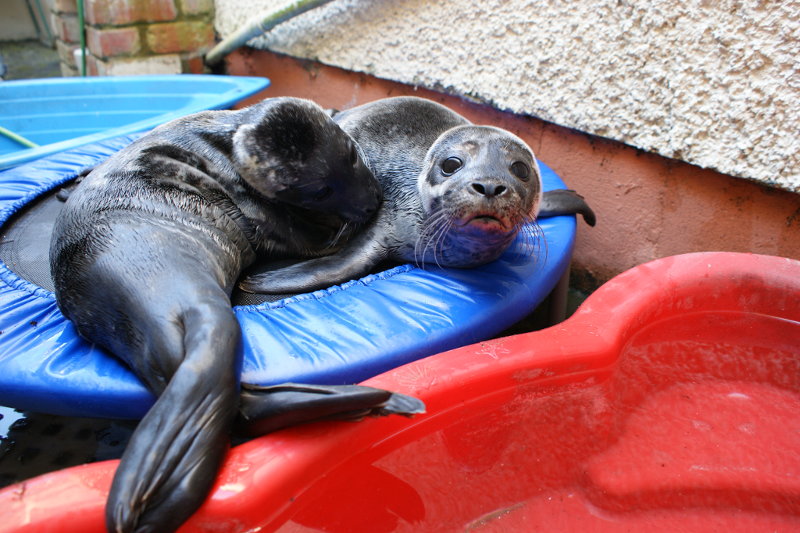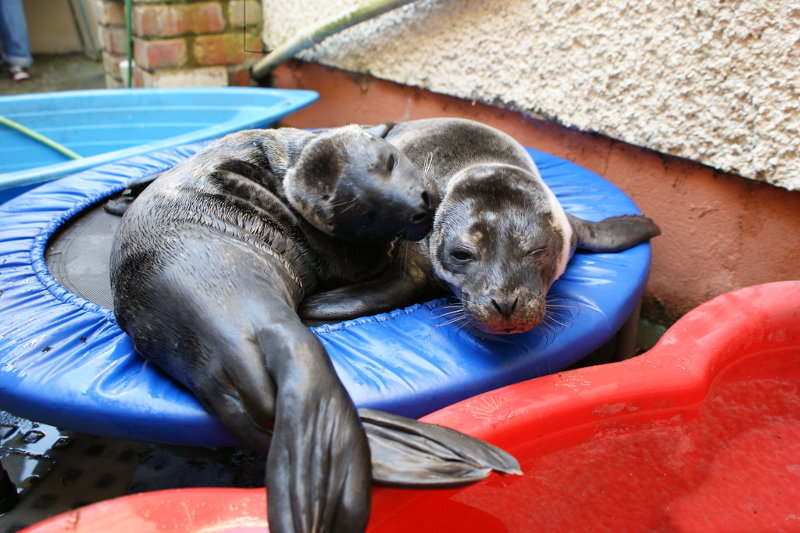Maxi and Mini
Maxi and Mini were found by army personnel at Ballykinler Base, Dundrum on July 19 2013. They were reported as two small pups moving together far from the main colony. When we arrived the pups were still together on the beach, several hundred yards upstream from the main colony. Judith from Exploris (our N. Ireland aquarium, where seal rehab is regularly carried out) met me at the site. We both agreed that the pups were 'orphans' who would have lost their mothers shortly after birth. We estimated the larger of the two pups to be about birth weight, while the smaller pup appeared underweight.. Both pups had lost their umbilical cord, but appeared to be in good condition, so we estimated their age at about 3-5 days. Exploris was already quite full with orphan pup arrivals from elsewhere in N. Ireland, and so Judith was quite happy for the two pups to come to Tara Seal Research for their rehab. Judith's support on the beach was much appreciated.


These photos show the pups as soon as they arrived at TSR on July 19. The pup on the right is Maxi, a male, who weighed 11.1 kg. The pup on the left is Mini, a female, who weighed 9.0 kg. 11 kg is average healthy birth weight for harbour seal pups, so our guess on the beach was quite good! Maxi amd Mini were originally temporary names while we thought of something rather more special - but somehow they just remained as Maxi and Mini!
As is evident from these photos, the pups were closely bonded to one another even at the time of their rescue. It is quite common for pups who have lost their mothers to follow one another and act to some extent as a mother-substitute for one another. Although they would, of course, starve to death in another day or two without our intervention, they nevertheless provide some comfort to one another. In the upper right photo Mini is nosing the back of Maxi's head - this area of fur produces an odour which is an attractant and involved in mother-pup - or in this case pup-pup - bonding. When a pup is following its mother in the water, it orientates to her back of head, and sometimes rides on her back with its nose buried in the fur of the back of her head.
The pups were fed successfully on our usual multi-milk formula. This is based on a high fat-high-protein milk powder which is almost lactose-free, made by Pet Ag in Illinois. To this we add tinned sardines, mackerel or pilchards (in brine), a small amount of fish oil, and add a special enzyme supplement (Essential Enzymes from Source Naturale). Our thanks to Joan Wright of Kruuse UK, who got us some multi-milk in a hurry, and thanks once again to Carol Stewart of Pet Ag in Illinois for arranging the multi-milk shipment from the US. Many thanks also to Pennine Healthcare, who donated some new feeding tubes.
We have had several pairs of pups for rehab in previous years, and although we have known that the pups spend virtually all of their time together, whether sleeping or active, we have actually never recorded the amount of time they spend together, asleep and active. This time we aimed to try to maintain a complete 24/7 record of their activity budget throughout their rehab period, and set up CCTV cameras to record this. As with previous pairs of pups, Maxi and Mini spent virtually all of their time close together and their activity was almost totally synchronised, whether they were sleeping or active in the water. We will analyse the CCTV record and publish the results on the pups' activity budget along with similar records we have made at other seal rehab centres in the past two years.
Sleeping together (left) and invitation to come into blue pool (right)
Maxi and Mini enjoyed synchronised sleeping, whether in the water or on the trampoline!
The pups always followed each other from one end of the yard to the other. The plastic buckets (empty multi-milk containers) were used a little later for a behaviour test (see below) - they were in the enclosure at this time for the pups to get used to them.
The pups played together in and out of the pools for their whole time in rehab, although as they grew larger the pools did seem to get smaller! Fortunately they were by then nearly ready to return to the sea!
This is their growth chart from rescue on July 19 to release on September 01. They each gained an average 0.3 kg/day
We know that all of our paired pups in rehab have always followed one another and slept and played together. This is because they are relating to one another in the same way that harbour seal pups relate to their mothers and they therefore experience similar primary socialisation that pups would normally have when they contact and interact with their mothers. However, in order to convince other people of the importance of keeping pups together, we needed to somehow demonstrate their need for a companion pup. To this end we carried out a type of behaviour test known in studies of animal welfare as a 'demand' test. In a demand test an animal has to show how much effort it is prepared to make to obtain a resource. In this case the 'resource' was the other pup. These tests were carried out under special licence from the Northern Ireland Environment Agency.
For the test we placed a barrier of water-filled buckets (with lids) across the middle of the yard, thus temporarily separating the pups just after we had fed the second pup. In each test the first pup had already gone to the other end of the yard, and so the barrier prevented the 'test' pup from following. In the first test Maxi was the 'test' pup and in the second Mini was the 'test' pup. In both tests the pups realised the buckets were too heavy to push and immediately started to try to climb over them - which was quite a struggle, considering the buckets were nearly as tall as they were. In both cases the test pup succeeded in reuniting with the other in only a few minutes. The tests were therefore able to demonstrate quite clearly how much these two pups needed to be together.
A series of screenshots taken from the CCTV cameras during both tests may be downloaded from the 'demand test' attachment links below.
On September 1st we attached (again under special licence from NIEA) small discs with the pup's name and our email address with glue to the fur of the head, so that if the pups should be found stranded ashore, we would hope to be notified. We also gave each pup a paintmark on their backs (0 for Mini, X for Maxi), so they might be able to be identified at a haul-out site from a distance.
Both pups were excellently behaved passengers in the car on the way to their release site at Murlough (Dundrum Bay). Murlough is just on the opposite bank of the estuary from Ballykinler beach, where the pups were originally rescued. In early September Ballykinler has about 170 common seals undergoing their annual moult, and several pups born in the Dundrum bay area still hang around the haul-out site while they practice their foraging techniques in the shallow waters nearby.
When we arrived at Murlough (you can see the Mourne Mountains in the background) the pups were carried down the beach to near the water's edge in custom-made nets. Once at the water's edge they needed a little encouragement to go into the water, but after half-an-hour they eventually discovered the joys of their natural element and started to swim and frolic in the middle of the narrow estuary, just a short distance from the seal colony on the opposite bank. Just like all our other pairs of pups at release, Maxi and Mini stayed very close to one another as they swam about in the water. This is one advantage of releasing socially-bonded pups together - they tend to swim around together around the haul-out site for a time, which must help them to get their geographical and topographical bearings before they swim off to start to learn to forage.
After about half an hour we lost them to view, but they were so close to the colony, with many seals swimming up and down along the shore, that we think it cannot have been difficult for them to realise they were back home at last.
At the time of writing (February 2014) there have been no reports of sightings of either pup, so we just hope that no news is good news, and we wish them both a long and happy life!
Thanks to our friend Christine who came and stayed to help out with the pups, and to Dom and Carrie who fed the pups several times and Dom weighed them when they became rather heavy and feisty to hold while standing on the scales! Thanks to Dom, Carrie and also to Kym, Ian and Maberta for all their much valued assistance in the final preparations and release of the pups.
